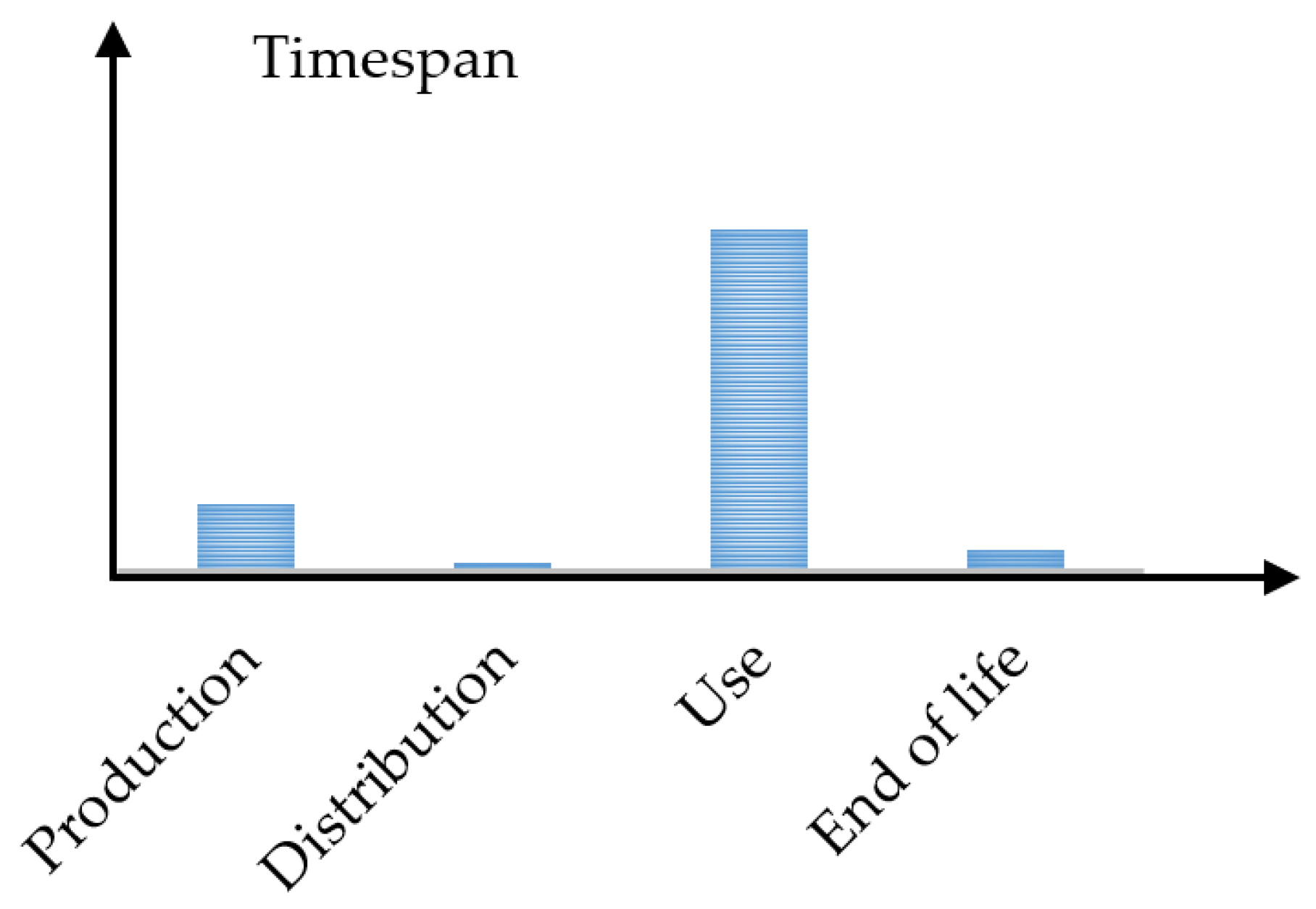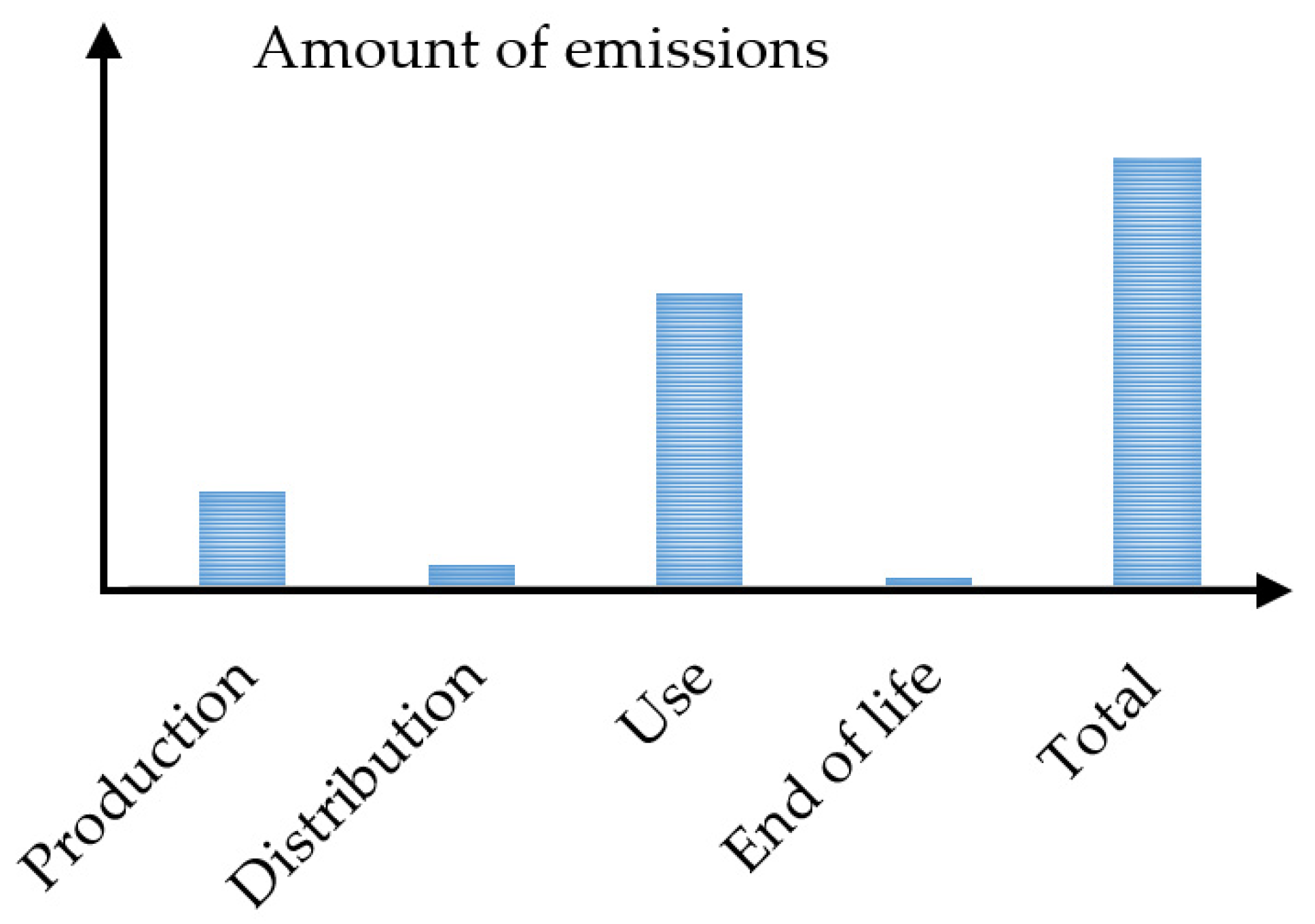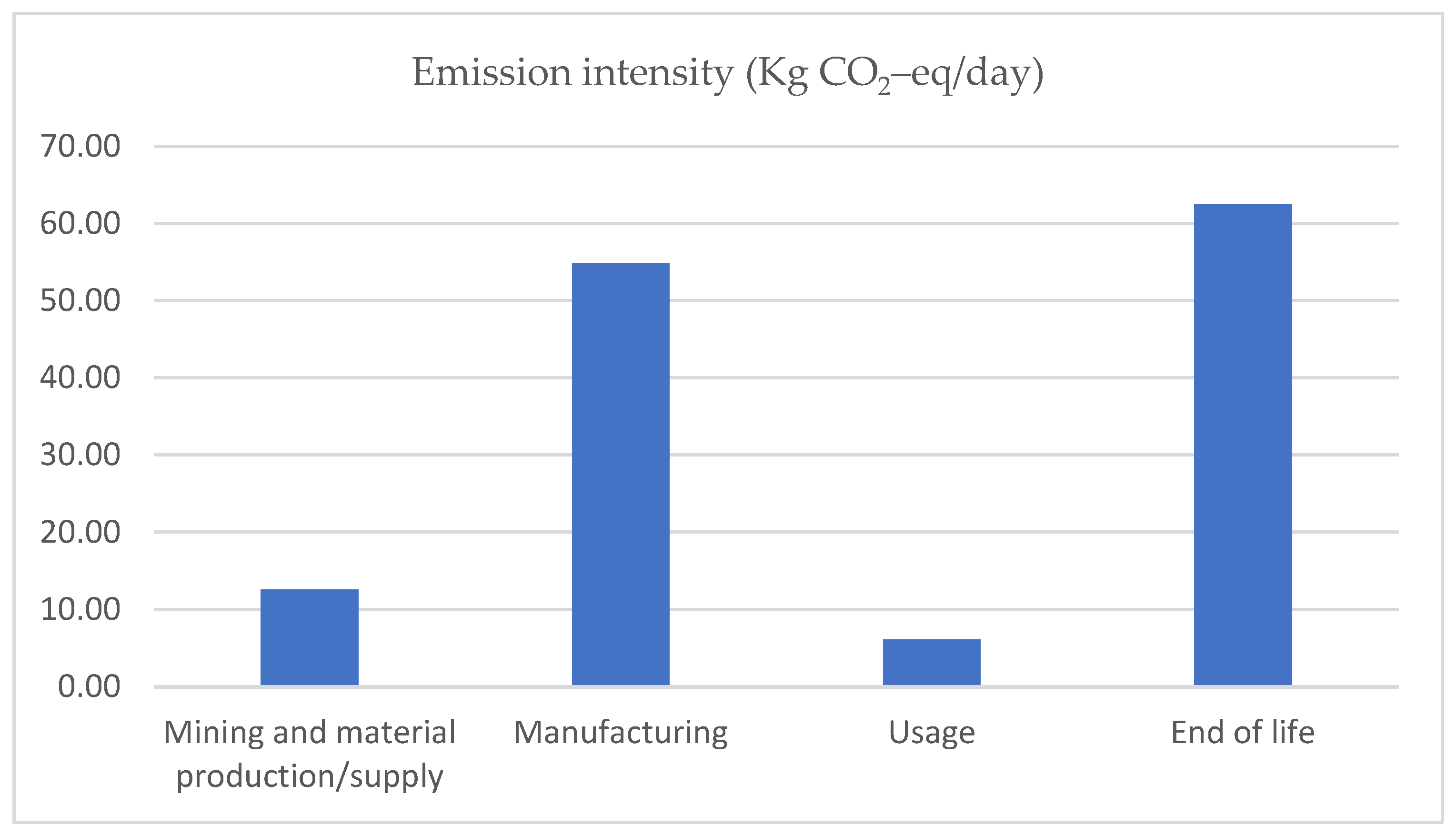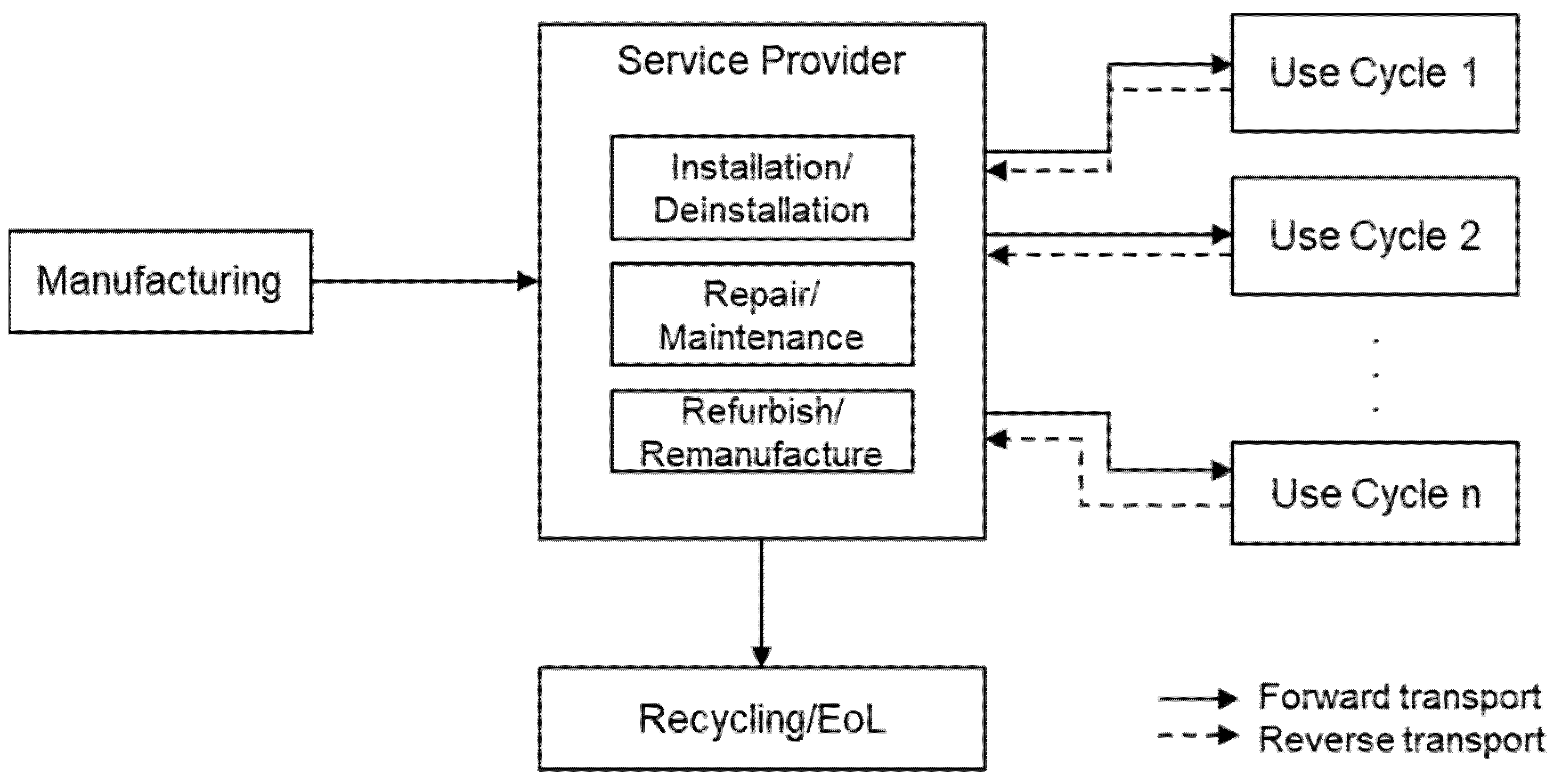Analyzing Temporal Variability in Inventory Data for Life Cycle Assessment: Implications in the Context of Circular Economy
Abstract
1. Introduction
2. A Brief Introduction to LCA Methodology
2.1. General Framework of LCA
2.2. Major Limitations of LCA Methodology
3. Perspectives on Temporal Dimension in LCA Literature
4. Implications of Conventional LCA Results for Practice and Policy
5. Proposed Approach
5.1. Proposed Approach to Calculate Emission Intensity
5.2. Implementation and Results
6. Implications of Emission Intensity in the Context of Circular Economy
| GHG emission intensity at time in life cycle phase | |
| Timespan of life cycle phase | |
| Aggregate GHG emissions in life cycle phase | |
| Number of life cycle phases | |
| Aggregate GHG emissions over the entire life cycle. |
7. Discussion and Conclusions
Author Contributions
Funding
Institutional Review Board Statement
Informed Consent Statement
Data Availability Statement
Acknowledgments
Conflicts of Interest
References
- Bevilacqua, M.; Ciarapica, F.E.; Giacchetta, G. LCA Process in the Eco-Design Process. In Design for Environment as a Tool for the Development of a Sustainable Supply Chain; Springer: London, UK, 2012; pp. 33–60. [Google Scholar] [CrossRef]
- ISO 14040:2006 Environmental Management—Life Cycle Assessment—Principles and Framework. Available online: https://www.iso.org/standard/37456.html (accessed on 1 January 2021).
- Owens, J.W. Life-Cycle Assessment: Constraints on Moving from Inventory to Impact Assessment. J. Ind. Ecol. 1997, 1, 37–49. [Google Scholar] [CrossRef]
- Yuan, C.; Wang, E.; Zhai, Q.; Yang, F. Temporal discounting in life cycle assessment: A critical review and theoretical framework. Environ. Impact Assess. Rev. 2015, 51, 23–31. [Google Scholar] [CrossRef]
- ISO. 14044:2006 Environmental Management—Life Cycle Assessment—Requirements and Guidelines. Available online: https://www.iso.org/standard/38498.html (accessed on 1 January 2021).
- Anand, C.K.; Amor, B. Recent developments, future challenges and new research directions in LCA of buildings: A critical review. Renew. Sustain. Energy Rev. 2017, 67, 408–416. [Google Scholar] [CrossRef]
- Finnveden, G.; Hauschild, M.Z.; Ekvall, T.; Guinée, J.; Heijungs, R.; Hellweg, S.; Koehler, A.; Pennington, D.; Suh, S. Recent developments in life cycle assessment. J. Environ. Manag. 2009, 91, 1–21. [Google Scholar] [CrossRef]
- Weidema, B.P. New Developments in the Methodology for LCA. In Proceedings of the 3rd International Conference on Ecobalance, Tsukuba, Japan, 25–27 November 1998. [Google Scholar]
- Gibon, T.; Schaubroeck, T. Lifting the fog on characteristics and limitations of hybrid LCA—A reply to “Does hybrid LCA with a complete system boundary yield adequate results for product promotion? Int. J. Life Cycle Assess. 2017, 22, 1005–1008. [Google Scholar] [CrossRef]
- Yang, Y. Does hybrid LCA with a complete system boundary yield adequate results for product promotion? Int. J. Life Cycle Assess. 2017, 22, 456–460. [Google Scholar] [CrossRef]
- Yang, Y.; Heijungs, R.; Brandão, M. Hybrid life cycle assessment (LCA) does not necessarily yield more accurate results than process-based LCA. J. Clean. Prod. 2017, 150, 237–242. [Google Scholar] [CrossRef]
- Rebitzer, G.; Ekvall, T.; Frischknecht, R.; Hunkeler, D.; Norris, G.; Rydberg, T.; Schmidt, W.-P.; Suh, S.; Weidema, B.P.; Pennington, D.W. Life cycle assessment: Part 1: Framework, goal and scope definition, inventory analysis, and applications. Environ. Int. 2004, 30, 701–720. [Google Scholar] [CrossRef]
- Curran, M.A. Strengths and limitations of life cycle assessment. In Background and Future Prospects in Life Cycle Assessment; Springer: Berlin/Heidelberg, Germany, 2014; pp. 189–206. [Google Scholar]
- Huijbregts, M.A. Application of uncertainty and variability in LCA. Int. J. Life Cycle Assess. 1998, 3, 273. [Google Scholar] [CrossRef]
- Reap, J.; Roman, F.; Duncan, S.; Bras, B. A Survey of Unresolved Problems in Life Cycle Assessment. Part 1: Goal and Scope and Inventory Analysis. Available online: https://www.infona.pl/resource/bwmeta1.element.springer-4f0f90bb-d984-3957-8d68-e5ab47285d65 (accessed on 1 January 2021).
- Margni, M.; Curran, M.A. Life cycle impact assessment. In Life Cycle Assessment Handbook: A Guide for Environmentally Sustainable Products; Curran, M.A., Ed.; Scrivener Publishing LLC: Salem, MA, USA, 2012; pp. 67–103. [Google Scholar]
- Reap, J.; Roman, F.; Duncan, S.; Bras, B. A Survey of Unresolved Problems in Life Cycle Assessment. Part 2: Impact Assessment and Interpretation. Available online: https://link.springer.com/article/10.1007/s11367-008-0009-9 (accessed on 1 January 2021).
- Owens, J.W. Life-Cycle Assessment in Relation to Risk Assessment: An Evolving Perspective. Risk Anal. 1997, 17, 359–365. [Google Scholar] [CrossRef]
- Østergaard, N.; Thorsted, L.; Miraglia, S.; Birkved, M.; Rasmussen, F.N.; Birgisdottir, H.; Kalbar, P.; Georgiadis, S. Data driven quantification of the temporal scope of building LCAs. Procedia CIRP 2018, 69, 224–229. [Google Scholar] [CrossRef]
- Miller, S.A.; Moysey, S.; Sharp, B.; Alfaro, J. A stochastic approach to model dynamic systems in life cycle assessment. J. Ind. Ecol. 2013, 17, 352–362. [Google Scholar] [CrossRef]
- Björk, H.; Rasmuson, A. A method for life cycle assessment environmental optimisation of a dynamic process exemplified by an analysis of an energy system with a superheated steam dryer integrated in a local district heat and power plant. Chem. Eng. J. 2002, 87, 381–394. [Google Scholar] [CrossRef]
- Su, S.; Li, X.; Zhu, Y.; Lin, B. Dynamic LCA framework for environmental impact assessment of buildings. Energy Build. 2017, 149, 310–320. [Google Scholar] [CrossRef]
- Guinée, J.; Heijungs, R.; Oers, L.V.; Meent, D.V.D.; Vermeire, T.; Rikken, M. LCA Impact Assessment of Toxic Releases. Generic Modelling of Fate, Exposure and Effect for Ecosystems and Human Beings with Data for about 100 Chemicals; Dutch Ministry of Housing, Spatial Planning and Environment: Leiden, The Netherlands, 1996; p. 100. [Google Scholar]
- Sohn, J.; Kalbar, P.; Goldstein, B.; Birkved, M. Defining Temporally Dynamic Life Cycle Assessment: A Review. Integr. Environ. Assess. Manag. 2020, 16, 314–323. [Google Scholar] [CrossRef]
- Beloin-Saint-Pierre, D.; Albers, A.; Hélias, A.; Tiruta-Barna, L.; Fantke, P.; Levasseur, A.; Benetto, E.; Benoist, A.; Collet, P. Addressing temporal considerations in life cycle assessment. Sci. Total Environ. 2020, 743, 140700. [Google Scholar] [CrossRef]
- Lueddeckens, S.; Saling, P.; Guenther, E. Temporal issues in life cycle assessment—A systematic review. Int. J. Life Cycle Assess. 2020, 25, 1385–1401. [Google Scholar] [CrossRef]
- Kendall, A.; Chang, B.; Sharpe, B. Accounting for Time-Dependent Effects in Biofuel Life Cycle Greenhouse Gas Emissions Calculations. Environ. Sci. Technol. 2009, 43, 7142–7147. [Google Scholar] [CrossRef]
- Hellweg, S.; Hofstetter, T.B.; Hungerbuhler, K. Discounting and the environment should current impacts be weighted differently than impacts harming future generations? Int. J. Life Cycle Assess. 2003, 8, 8. [Google Scholar] [CrossRef]
- Yuan, C.Y.; Simon, R.; Mady, N.; Dornfeld, D. Embedded temporal difference in Life Cycle Assessment: Case study on VW Golf A4 CAR. In Proceedings of the 2009 IEEE International Symposium on Sustainable Systems and Technology, Phoenix, AZ, USA, 18–20 May 2009; pp. 1–6. [Google Scholar]
- Castro, M.B.G.; Remmerswaal, J.A.M.; Reuter, M.A. Life cycle impact assessment of the average passenger vehicle in the Netherlands. Int. J. Life Cycle Assess. 2003, 8, 297–304. [Google Scholar] [CrossRef]
- Samaras, C.; Meisterling, K. Life Cycle Assessment of Greenhouse Gas Emissions from Plug-in Hybrid Vehicles: Implications for Policy. Environ. Sci. Technol. 2008, 42, 3170–3176. [Google Scholar] [CrossRef] [PubMed]
- Xiao, R.; Zhang, Y.; Liu, X.; Yuan, Z. A life-cycle assessment of household refrigerators in China. J. Clean. Prod. 2015, 95, 301–310. [Google Scholar] [CrossRef]
- Broch, F.; Warsen, J.; Krinke, S. Implementing life cycle engineering in automotive development as a helpful management tool to support design for environment. In Life Cycle Management; Guido, S., Margin, M., Eds.; Springer: Dordrecht, The Netherlands, 2015; pp. 319–329. [Google Scholar] [CrossRef]
- Rashid, A.; Asif, F.M.A.; Krajnik, P.; Nicolescu, C.M. Resource Conservative Manufacturing: An essential change in business and technology paradigm for sustainable manufacturing. J. Clean. Prod. 2013, 57, 166–177. [Google Scholar] [CrossRef]
- Rashid, A.; Roci, M.; Asif, F.M.A. Circular Manufacturing Systems. In Handbook of the Circular Economy; Miguel, B., David, L., Goran, F., Eds.; Edward Elgar Publishing: Cheltenham, UK, 2020. [Google Scholar]
- Foundation, E.M. Infographic—Circular Economy System Diagram. Available online: https://www.ellenmacarthurfoundation.org/circular-economy/infographic (accessed on 15 July 2020).
- Asif, F.M.A.; Bianchi, C.; Rashid, A.; Nicolescu, C.M. Performance analysis of the closed loop supply chain. J. Remanuf. 2012, 2. [Google Scholar] [CrossRef]
- WRAP. Environmental Life Cycle Assessment (LCA) Study of Replacement and Refurbishment Options for Domestic Washing Machines; MDD019; Waste and Resources Action Programme: Banbury, UK, 2010. [Google Scholar]






| Reference | Product Type | Identified Significant Issues | Implications for Practice | Implications for Policy |
|---|---|---|---|---|
| [30] | Automotive (Passenger Vehicle) | The largest environmental impact occurs in the use phase due to the combustion and depletion of fossil fuels | Future efforts should consider the reduction of the environmental impact of the use phase | Future legislation efforts should be based on the environmental impact of the emissions rather than only on their amounts |
| [31] | Automotive (Plug-in Hybrid Vehicle -PHEVs) | Electricity consumption in the use phase has a major impact on GHG emissions; lithium-ion battery materials and production account for 2–5% of life cycle emissions | The lifetime and performance of the battery is an important parameter for the economic and environmental success of PHEVs | Public policies that complement PHEV adoption should focus on encouraging charging with low-carbon electricity |
| [32] | Household Refrigerator | Electricity consumption in the use phase has the highest environmental impact along with material consumption during the production phase | Study suggests improvements in product design, advances in manufacture practices, consumer encouragement, supply chain optimization | Emphasizes the importance of a better understanding of the life cycle environmental impacts of Chinese refrigerators and ways to improve its sustainability |
| [33] | Automotive (Passenger Vehicle) | Use phase is responsible for 79% of GHG emissions | Mass reduction with lightweight design options | Life cycle-based improvement forms an integral part of Volkswagen’s corporate policy and environmental strategy |
| Life Cycle Phases. | GHG Emissions (Kg CO2–eq) | Timespan (days) | Emission Intensity (Kg CO2–eq/day) |
|---|---|---|---|
| Mining and material production/supply | 4439.80 | 354 | 12.54 |
| Manufacturing | 1180.20 | 21.5 | 54.89 |
| Usage | 22,199.00 | 3650 | 6.08 |
| End of life | 281.00 | 4.5 | 62.44 |
Publisher’s Note: MDPI stays neutral with regard to jurisdictional claims in published maps and institutional affiliations. |
© 2021 by the authors. Licensee MDPI, Basel, Switzerland. This article is an open access article distributed under the terms and conditions of the Creative Commons Attribution (CC BY) license (http://creativecommons.org/licenses/by/4.0/).
Share and Cite
Shoaib-ul-Hasan, S.; Roci, M.; Asif, F.M.A.; Salehi, N.; Rashid, A. Analyzing Temporal Variability in Inventory Data for Life Cycle Assessment: Implications in the Context of Circular Economy. Sustainability 2021, 13, 344. https://doi.org/10.3390/su13010344
Shoaib-ul-Hasan S, Roci M, Asif FMA, Salehi N, Rashid A. Analyzing Temporal Variability in Inventory Data for Life Cycle Assessment: Implications in the Context of Circular Economy. Sustainability. 2021; 13(1):344. https://doi.org/10.3390/su13010344
Chicago/Turabian StyleShoaib-ul-Hasan, Sayyed, Malvina Roci, Farazee M. A. Asif, Niloufar Salehi, and Amir Rashid. 2021. "Analyzing Temporal Variability in Inventory Data for Life Cycle Assessment: Implications in the Context of Circular Economy" Sustainability 13, no. 1: 344. https://doi.org/10.3390/su13010344
APA StyleShoaib-ul-Hasan, S., Roci, M., Asif, F. M. A., Salehi, N., & Rashid, A. (2021). Analyzing Temporal Variability in Inventory Data for Life Cycle Assessment: Implications in the Context of Circular Economy. Sustainability, 13(1), 344. https://doi.org/10.3390/su13010344







